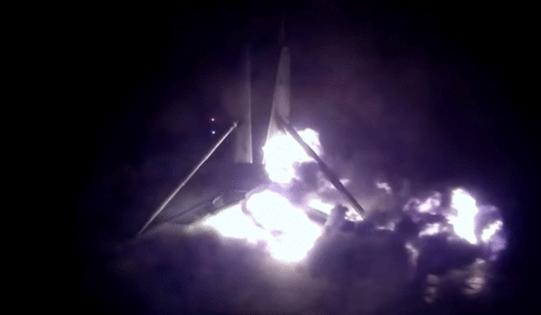FAA grounds Falcon 9 after fiery end to SpaceX booster; Polaris Dawn could face further delays
Published in News & Features
CAPE CANAVERAL, Fla. — The Federal Aviation Administration grounded SpaceX’s Falcon 9 rocket Wednesday after an early morning launch ended with the fiery demise of its first-stage booster.
The move is likely to further delay billionaire Jared Isaacman’s planned return to space on the Polaris Dawn mission, which had its own launch called off because of weather concerns.
“The FAA is aware an anomaly occurred during the SpaceX Starlink Group 8-6 mission that launched from Cape Canaveral Space Force Station in Florida on August 28,” reads an emailed statement from the FAA. “The incident involved the failure of the Falcon 9 booster rocket while landing on a droneship at sea. No public injuries or public property damage have been reported. The FAA is requiring an investigation.”
The FAA investigates commercial space incidents to determine the root cause and identify corrective actions so they won’t happen again. SpaceX will lead the investigation and submit a final report that the FAA must approve before it will let the Falcon 9 fly again.
The timeline for that report and approval is in question, and could take any chance SpaceX would be able to launch Polaris Dawn later this week off the board.
“A return to flight of the Falcon 9 booster rocket is based on the FAA determining that any system, process, or procedure related to the anomaly does not affect public safety,” the FAA statement reads. “In addition, SpaceX may need to request and receive approval from the FAA to modify its license that incorporates any corrective actions and meet all other licensing requirements.”
This is the second time this year the FAA has grounded Falcon 9 following an incident during a California launch July 11 during which the second-stage engine froze over in space and was not able to put its payloads into the correct orbit. SpaceX led a quick investigation with remedies to that mishap and the FAA allowed it to return to flight two weeks after the incident.
A two-week delay for Polaris Dawn, though, would potentially run it afoul of the Falcon Heavy launch of NASA’s Europa Clipper planned from the KSC pad in October, the preparations for which have to begin in mid-September. SpaceX could opt to shift Polaris Dawn to the Canaveral pad, though, which is where they plan to launch the next ISS crew rotation flight from, the Crew-9 mission set to launch no earlier than Sept. 24.
It’s just another potential delay for Polaris Dawn that saw an early Tuesday attempt called off because of a helium leak on the KSC pad.
The domino effect of bad news came after SpaceX determined weather days from now was not safe enough to launch Isaacman and his three crewmates from KSC’s Launch Pad 39-A. Because their ride, the SpaceX Crew Dragon Resilience, won’t be heading to the International Space Station but instead just making an orbital trip, landing zones off the coast of Florida have to be within safety margins for its planned return five days after launch.
SpaceX made the call late Tuesday to beg off the Polaris Dawn launch attempt early Wednesday as well as a backup option Thursday. The soonest it could fly would be early Friday, but not if Falcon 9 remains grounded.
With the Polaris Dawn launch off the board, though, SpaceX still opted to follow through with a second planned launch from Canaveral’s Space Launch Complex 40, which lifted off at 3:48 a.m. sending up another 21 Starlink satellites and marking the Space Coast’s 60th launch of the year.
The first-stage booster made a record 23rd trip to space and was actually the same booster that took Isaacman to space back in 2021 on the Inspiration4 mission.
That booster, though, tipped over and met a fiery end of service during its landing attempt on one of SpaceX’s droneships in the Atlantic.
“After a successful ascent, Falcon 9’s first stage booster tipped over following touchdown on the A Shortfall of Gravitas droneship. Teams are assessing the booster’s flight data and status, SpaceX posted on X soon after.
It’s the first time SpaceX has lost a booster on landing since 2021. The feed from SpaceX’s launch coverage cut out just after the booster was seen tipping backward away from the camera while flames continued to spew from its base as one of its landing legs collapsed.
SpaceX founder Elon Musk added, “Now we figure out what went wrong to drive the landing failure rate far above 1 in a thousand, then 1 in 10 thousand … 1 in a million, etc.”
SpaceX managed the first successful booster recovery in 2015, and has had 341 successful landings among its Falcon 9 and Falcon Heavy boosters since. Its destruction ends a streak of 267 successful landings in a row since the last incident in 2021.
Known as Booster 1062, it flew Inspiration4 and one other crewed flight, Axiom Space’s Ax-1 mission as well as commercial GPS and communication satellite missions and 16 flights for Starlink. It’s currently the fleet leader for launches, although three other boosters remain active for SpaceX with 20 or more launches.
“1062 had an amazing run,” Isaacman posted on X after its demise.
His Inspiration4 crewmate Sian Proctor weighed in as well saying, “Nooooo!! Not the @inspiration4x booster!! You served us well! RIP” with four sad face emojis along with several photos, including one of Proctor lovingly touching the side of it.
SpaceX lost another record-breaking booster that had also carried humans to space during rough weather as the droneship it was on made its trip back to Port Canaveral in 2023. That booster was used on the historic Demo-2 mission with NASA astronauts Bob Behnken and Doug Hurley, the first Crew Dragon flight with humans. When it tipped over, more than half of it broke off and sunk into the ocean. It had at the time been the fleet leader having launched and landed 19 times.
Since then, four boosters including 1062 have surpassed it as SpaceX aims to be able to refly each booster up to 40 times.
SpaceX stood down from another planned Starlink launch in California planned for later Wednesday morning to give teams time to look at the booster landing failure.
So for what had planned to be a busy night with three launches across three pads in Florida and California, SpaceX ended up only flying one.
The night started off with the latest delay for Polaris Dawn, which had to call off its first attempt this week, which was targeting early Tuesday, because of a helium leak on KSC’s Launch Pad 39-A. Now weather in the recovery area has taken out the Wednesday and Thursday morning opportunities.
“Due to unfavorable weather forecasted in Dragon’s splashdown areas off the coast of Florida, we are now standing down from tonight and tomorrow’s Falcon 9 launch opportunities of Polaris Dawn,” SpaceX posted on X late Tuesday. “Teams will continue to monitor weather for favorable launch and return conditions.”
It’s uncertain if SpaceX would try for an early Friday morning launch opportunity, but the Eastern Range has a launch window open for the mission from 3:33-7:15 a.m. Friday, Saturday and Sunday.
“The ascent corridor is go, it’s the splashdown locations day 5 that are not favorable,” Isaacman posted late Tuesday to X.
“Our launch criteria are heavily constrained by forecasted splashdown weather conditions,” he added. “With no ISS rendezvous and limited life support consumables, we must be absolutely sure of reentry weather before launching. As of now, conditions are not favorable tonight or tomorrow, so we’ll assess day by day.”
He said he’s not discouraged by the delay.
“As Elon mentioned, Polaris Dawn is a challenging mission with critical objectives, so we’ll wait for the best opportunity to ensure success. Sometimes, the hardest journeys require the most patience, and we’re ready to wait for the right moment. We know many have traveled to see the launch, and we’re grateful for your support. Alongside @SpaceX, we’ll do our best to keep you updated.”
Whatever the helium leak issue was Monday, though, was not in line to halt the attempt.
“While it’s a bummer to not step into a launch attempt tonight, I’m very proud of the team for identifying an issue and then digging in,” Kiko Dontchev, SpaceX vice president of launch, posted on X regarding Monday’s leak. “Nothing is more important than the safety of our astronauts and the reliability of our vehicles and operation.”
“We are grateful to all our friends, family, and supporters who have come out to @NASAKennedy for the launch,” Isaacman posted on X. “The best aerospace engineers in the world are working on the issue, and we promise to put on a great show soon enough!”
Elon Musk weighed in as well.
“An incredible amount of work has gone into this historic mission by an amazing team. We are triple-checking everything to make sure there is nothing more we can do to improve crew safety,” Musk posted.
“More time in quarantine to prepare is never a bad thing,” Isaacman later posted. “We’re well-informed on the issue and resolution. It’s immensely comforting to have the full support of @SpaceX & leadership, including Elon, ensuring mission’s safety. When the call comes, we won’t hesitate to strap in.”
When it does launch, the first-stage booster, which is making its fourth flight, will aim for a recovery landing downrange in the Atlantic on the droneship A Shortfall of Gravitas.
The Crew Dragon Resilience is flying for the third time, having debuted on the Crew-1 mission in 2020 and flown the Inspiration4 mission in 2021.
That second flight was Isaacman’s first trip to space, a three-day orbital mission that was the first ever all-commercial spaceflight that raised more than $250 million for St. Jude Children’s Research Hospital.
In 2022, Isaacman announced the Polaris Program in partnership with SpaceX with up to three missions — with Polaris Dawn as the first. The final mission would be the first crewed flight of the in-development Starship and Super Heavy.
But first up, Isaacman will be flying with one of his pilot buddies, former Air Force pilot Scott Poteet, and two SpaceX employees, Sarah Gillis and Anna Menon.
The highlight of the trip is what would be the first commercial spacewalk, targeting day three of the five-day orbital flight.
Isaacman and Gillis will venture outside the spacecraft that will open its hatch and vent the entire atmosphere out, meaning all four crew members will be wearing the new extravehicular activity spacesuits that SpaceX developed in the last 2½ years, and all breathing 100% oxygen.
Isaacman and Gillis will be connected to a 12-foot-long tether as they each spend about 15-20 minutes outside Resilience.
The flight also will take the spacecraft to a record 870-mile orbital altitude, test out a new Starlink communication experiment and tackle 40 more science and research efforts.
-------
©2024 Orlando Sentinel. Visit at orlandosentinel.com. Distributed by Tribune Content Agency, LLC.







Comments